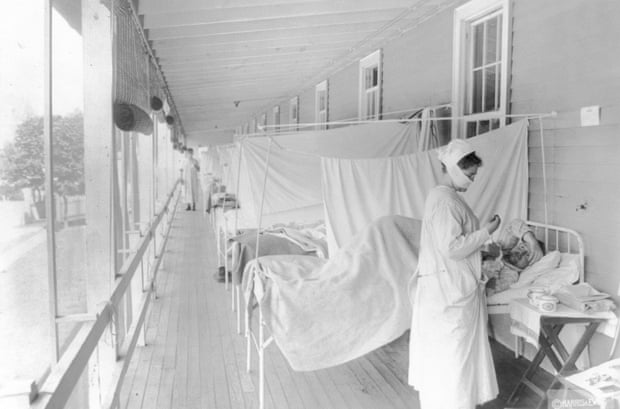Covid-19 has now killed as many Americans as the 1918-19 flu pandemic
More than 1,900 people are dying in the US daily on average – the highest level since early March
Covid-19 has now killed as many Americans as the 1918-19 flu pandemic – more than 675,000.
The US population a century ago was just one-third of what it is today, meaning the flu cut a much bigger, more lethal swath through the country. But the Covid-19 crisis is by any measure a colossal tragedy in its own right, especially given the incredible advances in scientific knowledge since then and the failure to take maximum advantage of the vaccines available this time.
“Big pockets of American society – and, worse, their leaders – have thrown this away,” said Dr Howard Markel a medical historian at the University of Michigan.
Like the 1918-19 flu, the coronavirus may never entirely disappear from our midst. Instead, scientists hope it becomes a mild seasonal bug as human immunity strengthens through vaccination and repeated infection. That could take time.
“We hope it will be like getting a cold, but there’s no guarantee,” said Rustom Antia, a biologist at Emory University, who suggests an optimistic scenario in which this could happen over a few years.
For now, the pandemic still has the United States and other parts of the world firmly in its jaws.
While the Delta variant-fueled surge in infections may have peaked, US deaths are more than 1,900 a day on average – the highest level since early March – and the country’s overall toll topped 675,000 Monday, according to the count kept by Johns Hopkins University, though the real number is believed to be higher.
Winter may bring a new surge, with the University of Washington’s influential model projecting an additional 100,000 or so Americans will die of Covid-19 by 1 January, which would bring the overall US toll to 776,000.
The 1918-19 influenza pandemic killed 50 million victims globally at a time when the world had one-quarter the population it does now. Global deaths from Covid-19 now stand at more than 4.6 million.
The 1918-19 flu’s US death toll is a rough guess, given the incomplete records of the era and the poor scientific understanding of what caused the illness. The 675,000 figure comes from the US Centers for Disease Control and Prevention.
Before Covid-19, the 1918-19 flu was universally considered the worst pandemic disease in human history. Whether the current scourge ultimately proves deadlier is unclear.
In many ways, the 1918-19 flu – which was wrongly named Spanish flu because it first received widespread news coverage in Spain – was worse.
Spread by the mobility of World War I, it killed young, healthy adults in vast numbers.
No vaccine existed to slow it, and there were no antibiotics to treat secondary bacterial infections. And, of course, the world was much smaller.
Yet jet travel and mass migrations threaten to increase the toll of the current pandemic. Much of the world is unvaccinated. And the coronavirus has been full of surprises.
Just under 64% of the US population has received as least one dose of the vaccine, with state rates ranging from a high of approximately 77% in Vermont and Massachusetts to lows around 46% to 49% in Idaho, Wyoming, West Virginia and Mississippi.
Globally, about 43% of the population has received at least one dose, according to Our World in Data, with some African countries just beginning to give their first shots.
“We know that all pandemics come to an end,” said Dr Jeremy Brown, director of emergency care research at the National Institutes of Health, who wrote a book on influenza. “They can do terrible things while they’re raging.”
Covid-19 could have been far less lethal in the US if more people had gotten vaccinated faster, “and we still have an opportunity to turn it around”, Brown said. “We often lose sight of how lucky we are to take these things for granted.”




